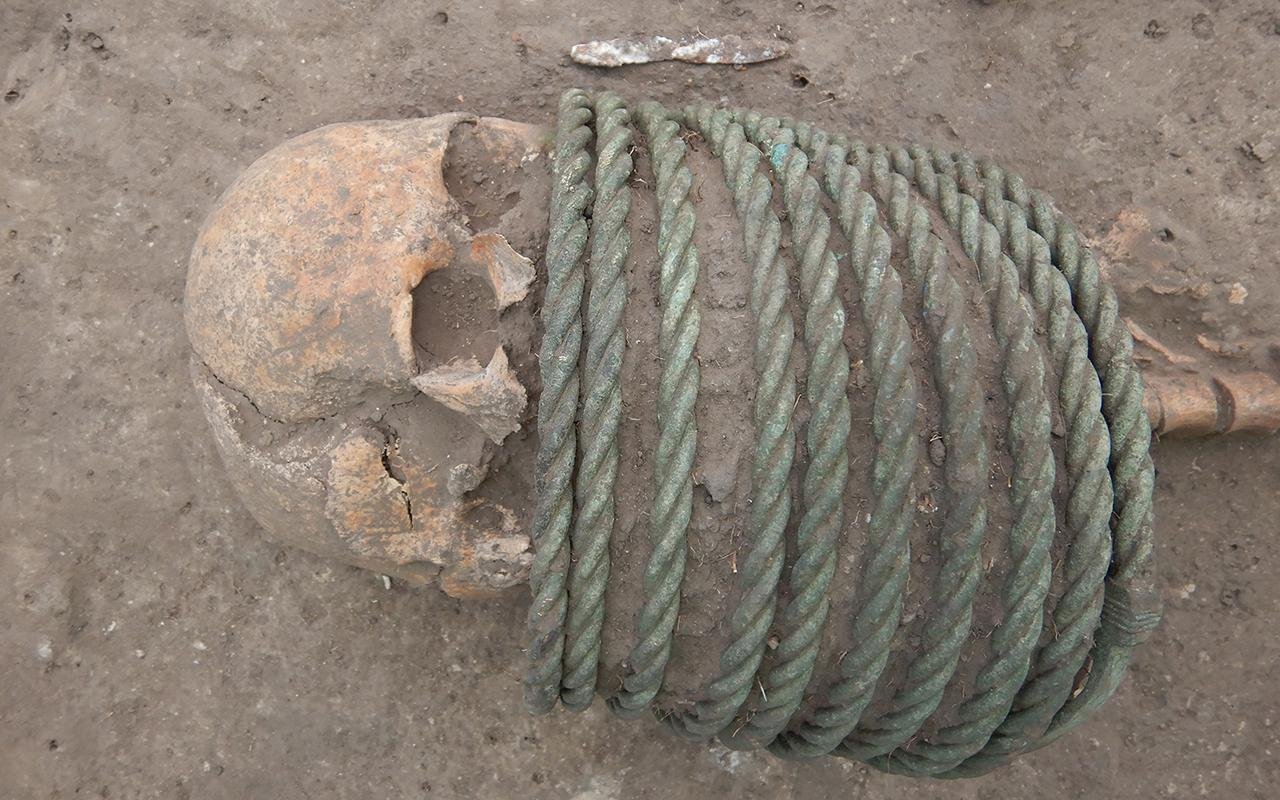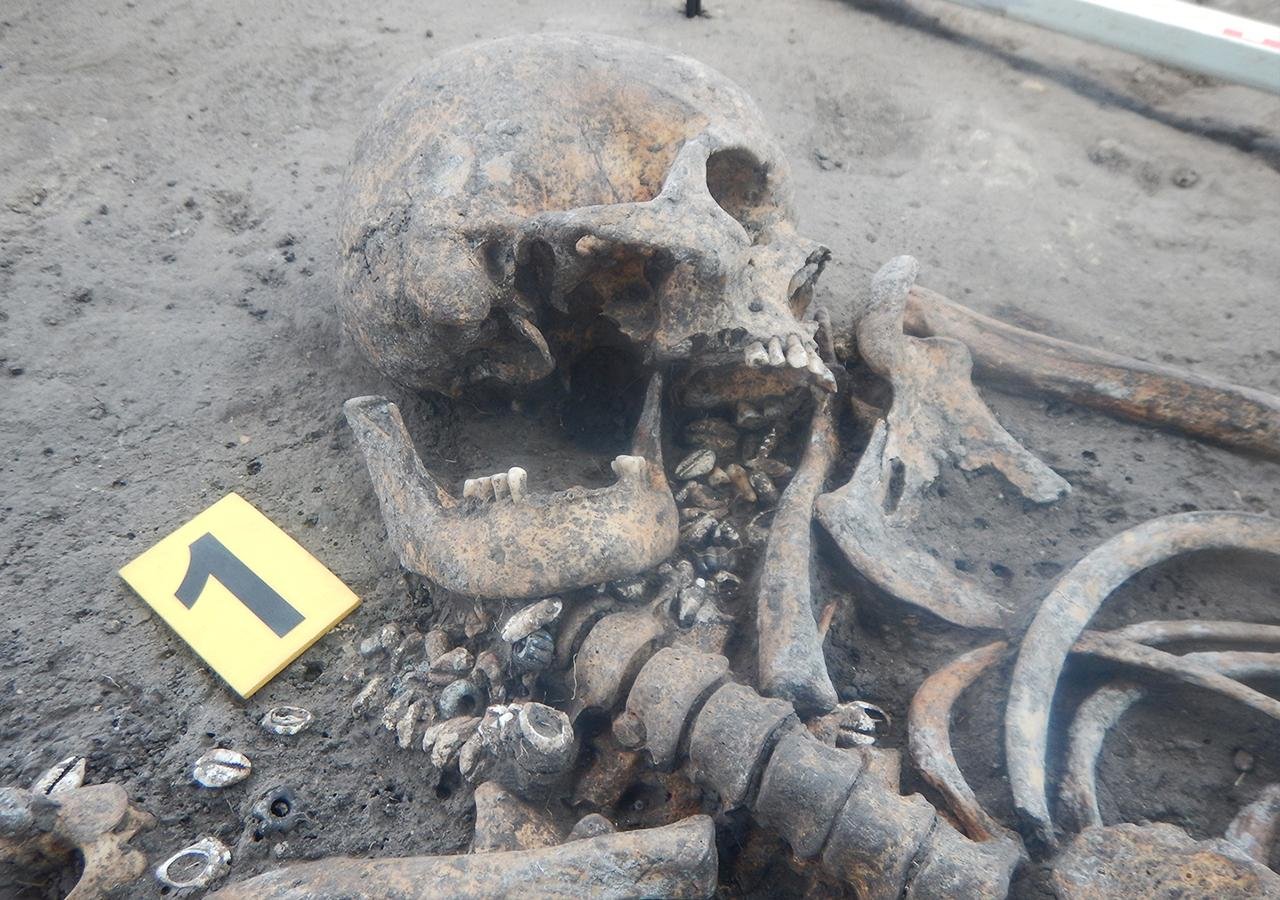In the heart of Ukraine, a remarkable archaeological discovery has emerged, shedding light on the rich cultural tapestry that has long defined this resilient nation. Nestled approximately 50 miles south of Kyiv, the village of Ostriv has become the site of a captivating 1,000-year-old cemetery, uncovered by a team of dedicated researchers from the National Academy of Sciences of Ukraine.
This remarkable find, explored between 2017 and 2022, has unveiled a treasure trove of information about the lives and customs of the individuals who called this region home during the 11th century. From the intricate bronze neck rings adorning the remains of a woman to the assortment of weapons found alongside the male burials, the Ostriv cemetery offers a glimpse into the social structures and practices that shaped the people of this era.
Exploring the Ostriv Cemetery
The Ostriv cemetery consists of 107 graves, with the majority of the identified burials placed in wooden coffins. This meticulous excavation, led by researchers Vsevolod Ivakin and Vyacheslav Baranov, has uncovered a wealth of information about the funerary customs and beliefs of the individuals laid to rest in this hallowed ground.

One of the most captivating discoveries is the skeleton of a woman who was buried with a remarkable set of bronze neck rings, as well as rings around her arms. These intricate adornments are believed to have served as social markers, indicating the status and importance of the individual within their community. Such ornate burials provide valuable insights into the societal structures and the roles of women during this period in Ukraine’s history.
In addition to the woman’s ornate burial, the excavation also revealed that men were often interred with an assortment of weapons, including axes, spearheads, and swords. This suggests that the individuals buried in the Ostriv cemetery were likely members of a warrior class or held positions of military importance within their society.
Unique Burial Practices and Cultural Influences
The Ostriv cemetery also showcases a distinctive orientation of the graves, with the majority facing south and west, rather than the typical northward direction observed in the Kyivan Rus during the same era. This deviation from the norm suggests the possible influence of cultural or religious factors on the burial customs of the individuals laid to rest in this hallowed ground.
Furthermore, the presence of wooden buckets placed at the feet of several individuals is particularly noteworthy, as it deviates from the customary burial practices observed in the region. The researchers suggest that these buckets may have been linked to specific funerary rituals or beliefs, offering a glimpse into the complex and diverse spiritual traditions that shaped the lives of the Ostriv community.
A comparison of the Ostriv cemetery with the burial practices of Western Baltic tribes has revealed both similarities and notable differences. While the orientation and funerary furnishings shared certain parallels, the absence of cremation burials, a hallmark of Baltic traditions, sets the Ostriv cemetery apart. Additionally, the presence of buckets in the burials is a distinct feature not observed in Baltic funerary practices.
The Influence of Christianization
The researchers believe that these variations in burial customs may be attributed to the constraints imposed on traditional funerary practices by the Christian dukes of Kyiv, particularly Volodymyr the Great (r. 980-1015) and Yaroslav the Wise (r. 1019-1054). The process of Christianization that swept through the region during the 11th century likely had a significant impact on the burial rituals of the Ostriv community, as they sought to reconcile their traditional beliefs with the new religious order.

The discovery of a stone altar within the cemetery further adds to the complexity of the site, suggesting that it may have served as a venue for both Christian and pagan rituals. This interplay of religious influences highlights the dynamic and evolving nature of the cultural landscape during this pivotal period in Ukraine’s history.
Connections to the Baltic Region
Some of the artifacts found at the Ostriv cemetery bear striking resemblance to those from the Baltic region, hinting at the possible presence of individuals who had migrated from that area to serve in the Kyivan rulers’ militaries. Volodymyr the Great’s expansive rule extended into the Baltic territories, and this period coincided with the widespread conversion to Christianity in Ukraine, as exemplified by Volodymyr’s own baptism around 987.
The connections between the Ostriv cemetery and the Baltic region underscore the complex web of cultural and political influences that shaped the lives of the individuals buried in this hallowed ground. These findings suggest that the Ostriv community may have been a melting pot of diverse backgrounds and traditions, reflecting the dynamic and interconnected nature of the region during the 11th century.
The Ongoing Challenge of Preserving Ukraine’s Heritage
Unfortunately, the ongoing excavations at the Ostriv cemetery, like many other archaeological projects in Ukraine, have been disrupted by the Russian invasion. This conflict has not only halted the exploration of this remarkable site but has also threatened the preservation of Ukraine’s rich cultural heritage.
Despite these challenges, the discoveries made at the Ostriv cemetery continue to offer invaluable insights into the past, shedding light on the diverse cultural and religious influences that have long defined the Ukrainian people. As the country navigates this turbulent period, the preservation of such historical treasures remains a crucial priority, ensuring that the stories of the past are not lost, but rather celebrated and cherished for generations to come.
Conclusion
The Ostriv cemetery stands as a testament to the resilience and cultural richness of Ukraine. This 1,000-year-old site has unveiled a tapestry of stories, from the ornate burials of the elite to the diverse religious and cultural influences that shaped the lives of the individuals laid to rest in this hallowed ground.
As we grapple with the ongoing challenges facing Ukraine, the Ostriv cemetery serves as a poignant reminder of the enduring spirit of the Ukrainian people. Their ability to adapt, evolve, and preserve their cultural heritage in the face of adversity is a testament to the strength and resilience that has long defined this remarkable nation.
Through the continued exploration and preservation of sites like Ostriv, we can gain a deeper understanding of Ukraine’s past and the forces that have forged its present. By honoring the stories of those who came before, we can better appreciate the richness and complexity of the Ukrainian experience, and find inspiration in the resilience and determination that have long defined this remarkable country.

